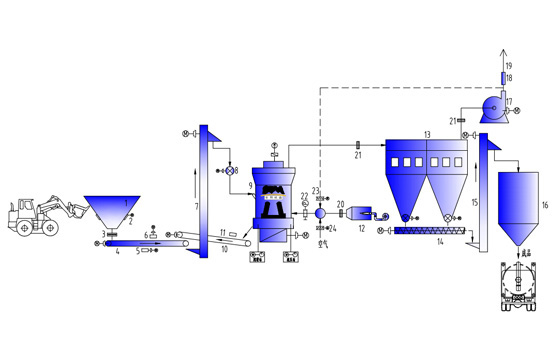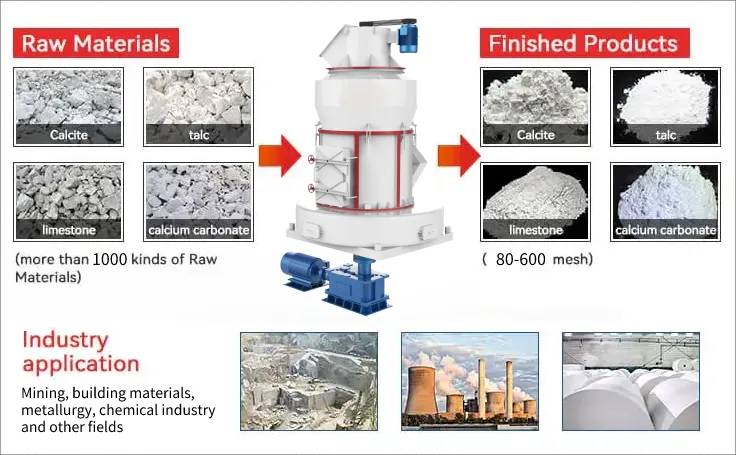What equipment is used for bentonite powder making?
About Bentonite
Bentonite generally has a hardness of 1-2 (some are relatively hard), and a density of 2-3g/cm3. Also known as bentonite, bentonite or bentonite, it is a non-metallic mineral with montmorillonite as the main mineral component. It is generally white and light yellow, and it is light gray, light green, pink and brown due to changes in iron content. Red, brick red, gray black, etc. Hardness 1~2, density 2~3g/cm3. According to the type, content and layer charge of montmorillonite, bentonite can be divided into sodium bentonite (alkaline soil), calcium bentonite (alkaline earth), natural bleaching earth (acidic soil or acid white clay), of which Calcium-based bentonite also includes calcium-sodium-based and calcium-magnesium-based.
The use of bentonite powder
Bentonite powder making is generally divided into four types: coarse powder processing (0-3mm), fine powder processing (20 mesh-400 mesh), superfine powder processing (400 mesh-1250 mesh) and micro powder processing (1250 mesh-3250 mesh).
● Below 200 mesh: used as feed, such as fish feed, etc., and also used as other additives.
● 200 mesh-325 mesh: drilling, paper making, etc.
● Above 325 mesh: chemical additives, paper.
Bentonite processing technology
1. Sodiumization stage: Most of the bentonite in nature is calcium-based bentonite, and the performance of calcium-based bentonite is poorer than that of sodium-based bentonite.
2. Drying stage: The sodium bentonite has a high moisture content and needs to be dried by a dryer to reduce the moisture content.
3. Milling stage: After drying, the bentonite is crushed until the ore that meets the feeding requirements of the mill is lifted by the elevator to the storage hopper, and then the electromagnetic vibrating feeder is evenly fed to the main machine of the mill. Grind.
4. Classification stage: The ground materials are classified through the powder classifier with the system airflow, and the unqualified powder is classified by the classifier and returned to the main mill for re-grinding.
5. Powder collection stage: the fine powder enters the powder collection system with the air flow through the pipeline, the air and powder are separated, and the finished powder is sent to the finished product silo by the conveying device, and then uniformly packed with a powder tanker or an automatic packing machine.

Bentonite powder making equipment
Fine powder processing can choose YGM high pressure mill, CLRM Raymond mill, etc.
For ultra-fine powder processing, HGM ring roller micro-powder mill and CLUM ultra-fine vertical mill can be selected.
Coarse powder processing can choose European coarse powder mill.
It is recommended to use Raymond mill for bentonite powder processing below 500 mesh. Raymond mill is the most important milling equipment in the bentonite milling production line. This equipment has certain pertinence to the milling of bentonite.

In addition to its high milling efficiency, it also has the following advantages:
a. Strong complete set: It can independently complete the grinding of bentonite to packaging, and the completion effect is also very good, without the help of other equipment.
b. Low failure rate: important parts are made of high-quality wear-resistant materials, which make them have strong wear-resistant and impact-resistant properties, so the number of failures during the working process is also very small.
c. Good sealing performance: the bentonite grinding operation can be carried out for a long time. Because the sealing performance of the equipment is very good, the normal operation of the equipment can be guaranteed.
d. High milling efficiency and high output: the milling effect on bentonite is good, and the milling efficiency of this equipment is also very high, which can greatly increase the yield of bentonite.
Features of Bentonite Grinding Production Line
1. Raymond Mill's bentonite grinding production line is reasonably configured and occupies a small area, which effectively reduces the customer's infrastructure funds.
2. The investment is small and the return is fast, which reduces the investment cost of the majority of customers, maximizes the benefits of the bentonite plant, and meets the requirements of all customers.
3. The working environment reduces pollution and is equipped with dust removal equipment, so the pollution in the working process is very small and the working environment is improved.
4. The sieving efficiency of the finished product is high, sometimes up to 99%, which is not available in other milling equipment, and can meet the customer's requirements for the particle size of the bentonite finished product.
